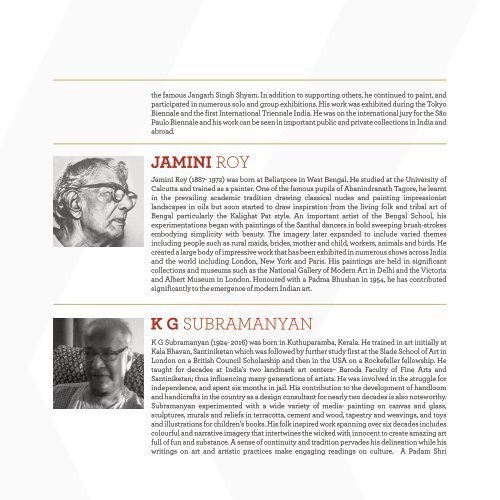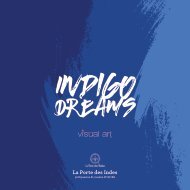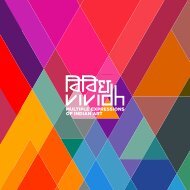Vividh 2016: Multiple Expressions of Indian Art
You also want an ePaper? Increase the reach of your titles
YUMPU automatically turns print PDFs into web optimized ePapers that Google loves.
the famous Jangarh Singh Shyam. In addition to supporting others, he continued to paint, and<br />
participated in numerous solo and group exhibitions. His work was exhibited during the Tokyo<br />
Biennale and the first International Triennale India. He was on the international jury for the São<br />
Paulo Biennale and his work can be seen in important public and private collections in India and<br />
abroad.<br />
JAMINI ROY<br />
Jamini Roy (1887- 1972) was born at Beliatpore in West Bengal. He studied at the University <strong>of</strong><br />
Calcutta and trained as a painter. One <strong>of</strong> the famous pupils <strong>of</strong> Abanindranath Tagore, he learnt<br />
in the prevailing academic tradition drawing classical nudes and painting impressionist<br />
landscapes in oils but soon started to draw inspiration from the living folk and tribal art <strong>of</strong><br />
Bengal particularly the Kalighat Pat style. An important artist <strong>of</strong> the Bengal School, his<br />
experimentations began with paintings <strong>of</strong> the Santhal dancers in bold sweeping brush-strokes<br />
embodying simplicity with beauty. The imagery later expanded to include varied themes<br />
including people such as rural maids, brides, mother and child, workers, animals and birds. He<br />
created a large body <strong>of</strong> impressive work that has been exhibited in numerous shows across India<br />
and the world including London, New York and Paris. His paintings are held in significant<br />
collections and museums such as the National Gallery <strong>of</strong> Modern <strong>Art</strong> in Delhi and the Victoria<br />
and Albert Museum in London. Honoured with a Padma Bhushan in 1954, he has contributed<br />
significantly to the emergence <strong>of</strong> modern <strong>Indian</strong> art.<br />
K G SUBRAMANYAN<br />
K G Subramanyan (1924- <strong>2016</strong>) was born in Kuthuparamba, Kerala. He trained in art initially at<br />
Kala Bhavan, Santiniketan which was followed by further study first at the Slade School <strong>of</strong> <strong>Art</strong> in<br />
London on a British Council Scholarship and then in the USA on a Rockefeller fellowship. He<br />
taught for decades at India's two landmark art centers– Baroda Faculty <strong>of</strong> Fine <strong>Art</strong>s and<br />
Santiniketan; thus influencing many generations <strong>of</strong> artists. He was involved in the struggle for<br />
independence, and spent six months in jail. His contribution to the development <strong>of</strong> handloom<br />
and handicrafts in the country as a design consultant for nearly two decades is also noteworthy.<br />
Subramanyan experimented with a wide variety <strong>of</strong> media- painting on canvas and glass,<br />
sculptures, murals and reliefs in terracotta, cement and wood, tapestry and weavings, and toys<br />
and illustrations for children's books. His folk inspired work spanning over six decades includes<br />
colourful and narrative imagery that intertwines the wicked with innocent to create amazing art<br />
full <strong>of</strong> fun and substance. A sense <strong>of</strong> continuity and tradition pervades his delineation while his<br />
writings on art and artistic practices make engaging readings on culture. A Padam Shri




